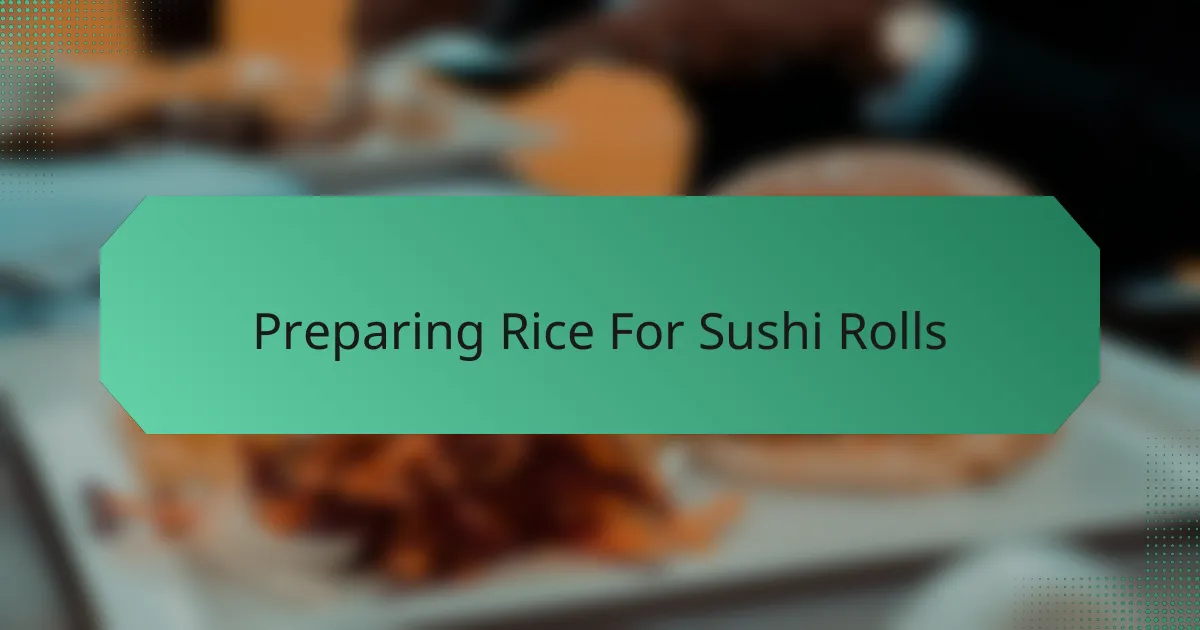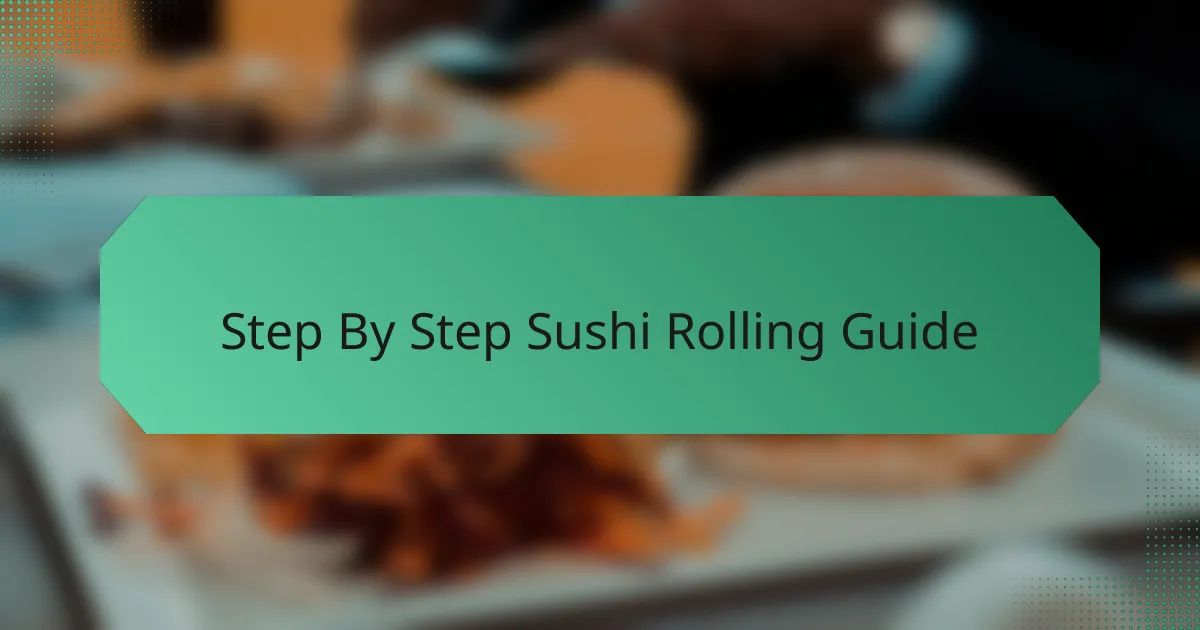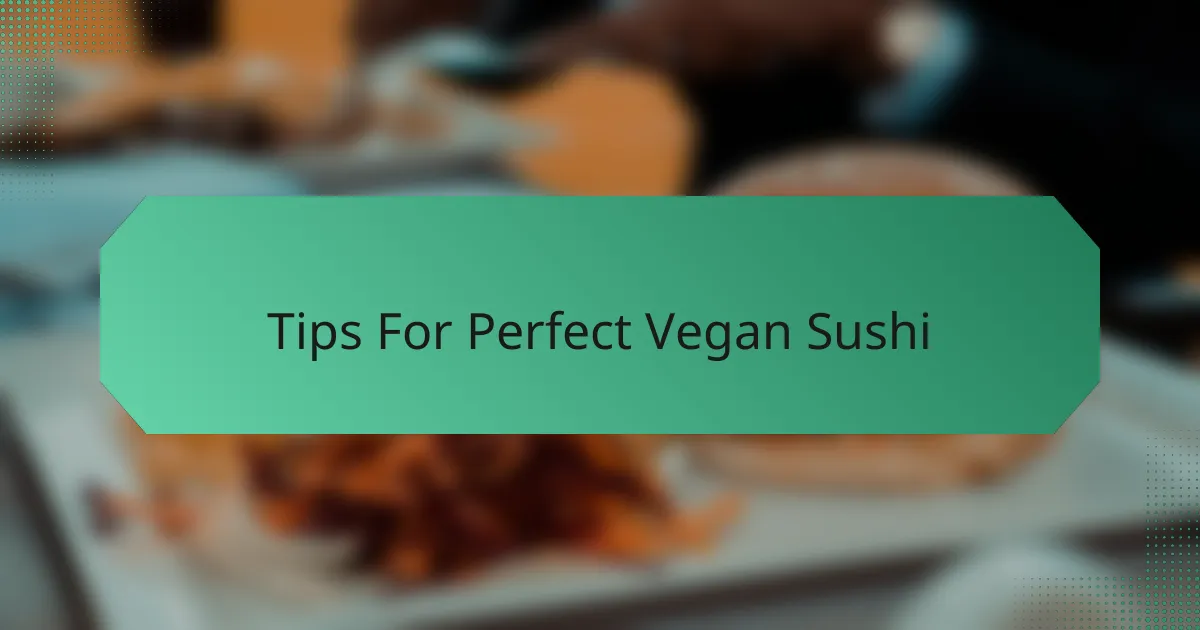Key takeaways
- Vegan sushi substitutes fish with plant-based ingredients, offering a variety of flavors through vegetables, tofu, and sauces.
- Essential ingredients include sushi rice, nori sheets, and fillings like fresh vegetables and marinated tofu, all contributing to the overall texture and taste.
- Proper preparation of sushi rice and fillings is crucial, including rinsing rice and applying the right moisture to vegetables to avoid sogginess.
- Mindful rolling technique and proper slicing are key to creating neatly shaped sushi rolls, enhancing both the presentation and enjoyment of the dish.

What Is Vegan Sushi
Vegan sushi is simply sushi made without any animal products, substituting traditional fish and seafood with plant-based ingredients. When I first tried vegan sushi, I was amazed at how fresh and satisfying it could be, even without the usual seafood flavors.
Have you ever wondered how sushi can be so flavorful without fish? For me, it’s all about the creative use of vegetables, tofu, and flavorful sauces that bring the rolls to life. This kind of sushi challenges the stereotype that sushi must involve raw fish to be delicious.
The beauty of vegan sushi is in its versatility—each roll can tell a unique story depending on the ingredients used. From crunchy cucumber to creamy avocado, these components create textures and tastes that make every bite an exciting experience, proving that sushi is truly for everyone.

Essential Ingredients For Vegan Sushi
When I first gathered the essential ingredients for vegan sushi, I realized how simple yet powerful each one can be. Sushi rice, seasoned with rice vinegar, sugar, and salt, is the foundation—it’s sticky and slightly tangy, perfect for holding everything together. Without the right rice, even the best fillings won’t give you that authentic sushi feel.
Have you ever tried rolling sushi without a bamboo mat? For me, it was a game-changer—it helps shape the rolls tight and neat. Alongside the rice and mat, nori sheets are indispensable; their subtle sea flavor adds depth and holds the fillings firmly.
Of course, the fillings themselves make all the difference. I love using fresh cucumber for crunch, creamy avocado for richness, and marinated tofu for protein. These ingredients bring vibrant colors and textures that make every bite exciting, reminding me why I keep coming back to vegan sushi.

Preparing Rice For Sushi Rolls
Getting the rice just right is where the magic starts for me. I remember the first time I tried making sushi rice—it was a bit sticky, slightly tangy, and perfectly soft, exactly what you want to hold your rolls together without falling apart. The trick? Using short-grain rice and rinsing it thoroughly until the water runs clear. This step took me by surprise, but it really washes away excess starch, making the rice less gummy.
Then comes seasoning, which I think is the secret sauce of good sushi rice. Mixing rice vinegar with a touch of sugar and salt creates this wonderful balance of sweet and tangy that brightens the whole roll. When I sprinkle this over the cooked rice while it’s still warm, I gently fold it in—never stirring aggressively—so the grains stay fluffy and shiny. It’s a little kitchen ritual that feels rewarding every time.
Have you ever wondered how to get rice to stick without turning into a mushy mess? From my experience, patience is key—letting the rice cool just enough before rolling helps it stick to the nori, but prevents it from becoming overly sticky. That delicate texture is what makes each bite of vegan sushi feel authentic and satisfying.

Selecting And Preparing Fillings
Choosing the right fillings always feels like an exciting part of making vegan sushi for me. I found that fresh, crisp vegetables like julienned carrots and thinly sliced bell peppers add just the kind of crunch that balances the softness of the rice. Have you noticed how a good mix of textures can turn a simple roll into something truly memorable?
Preparing the fillings takes a bit of attention, but it’s rewarding. For instance, marinating tofu with soy sauce and a touch of sesame oil really elevated my rolls by adding depth and umami without overpowering the other ingredients. I learned that the key is to keep the flavors balanced so each bite surprises you without overwhelming your palate.
Sometimes, I like to experiment with more adventurous fillings like pickled radish or blanched asparagus. Have you ever tried quick-pickling veggies? It’s a technique that adds a bright zing and makes the rolls pop with flavor. This step made me realize that preparing fillings thoughtfully can transform vegan sushi from good to unforgettable.

Step By Step Sushi Rolling Guide
Rolling sushi for the first time felt both exciting and a little daunting to me. I learned soon enough that laying the nori sheet shiny side down on the bamboo mat is crucial—it’s like setting the stage for a great performance. From there, spreading the rice evenly but not too thickly was a lesson in balance; too much rice and the roll becomes bulky, too little and it falls apart.
Have you ever struggled with rolling sushi tightly enough so it doesn’t unravel? I certainly did! I found that using my fingers to gently press and tuck the fillings as I rolled makes all the difference. The bamboo mat isn’t just for show—it really helps shape the roll firmly without squashing the ingredients, giving you that neat, classic sushi look.
Once the roll is complete, trimming it carefully with a sharp knife was a game-changer for me. I used to slice too quickly, and the rolls would squish or tear. Taking it slow, wiping the knife clean between cuts, and applying just the right pressure turned my sushi rolling from a messy experiment into a satisfying, almost meditative craft. Have you tried this technique yet? It really helped me enjoy each step more.

Tips For Perfect Vegan Sushi
One tip that really helped me perfect my vegan sushi was mastering the moisture level of the rice and fillings. Have you ever ended up with soggy rolls that just fall apart? I learned to gently squeeze out excess water from veggies like cucumber before rolling, which kept everything crisp and helped the rice maintain its sticky texture without getting mushy.
I also discovered that using a sharp knife for slicing the rolls makes a world of difference. At first, I was frustrated by uneven cuts and crushed rolls, but once I switched to a razor-sharp blade and wiped it clean between slices, the sushi looked so neat and professional. It’s such a satisfying moment when your rolls hold their shape perfectly—trust me, it boosts your confidence in the kitchen.
Lastly, don’t rush the rolling process. I used to hurry through it and end up with loose, messy sushi, but slowing down and applying even pressure with the bamboo mat transformed the results. It feels almost meditative, like you’re molding edible art. Have you tried this mindful approach? It made sushi-making feel less intimidating and way more enjoyable for me.

Serving And Storing Vegan Sushi
When it comes to serving vegan sushi, I find that letting the rolls rest for a few minutes after slicing helps the flavors marry together beautifully. Have you noticed how freshly cut rolls sometimes seem a bit fragile? Giving them a short break lets the rice settle, so each bite holds perfectly without falling apart.
Storing leftover vegan sushi requires a bit of care to keep it tasting fresh. In my experience, wrapping the rolls tightly in plastic wrap and placing them in an airtight container in the fridge works best. It’s amazing how this simple step preserves the texture and prevents the rice from drying out overnight.
I’ve also learned that while vegan sushi is best enjoyed the same day, it can still hold up well for up to 24 hours if stored properly. Have you tried reheating your sushi? I personally avoid microwaving because it ruins the texture, so I stick to enjoying it cold or at room temperature, which keeps that satisfying bite intact.